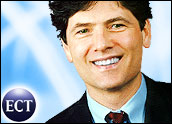
When Marc Benioff asked me in New York what I thought of last week’s Salesforce.com briefing and demonstration of CustomForce, I had to tell him the truth. I was impressed but not surprised — after all, I have been writing about this approach to new application development and integration for over a year and the demo confirmed my predictions. But I was not and am still not trying to brag about it. Truth be told, I thought it would take years to get to this point — it happened a lot faster than I had expected.
What exactly happened? With the introduction of CustomForce 2.0, Salesforce.com has gone a long way toward enabling its customers to build applications on top of the CRM system or more precisely, to use the system resources to build new applications that might or might not be integrated with the core technology. All of those little “applications” end users once made by tracking data in a spreadsheet or a small database are now officially as outdated as the fins on your grandfather’s Oldsmobile.
System Architecture
Rather than using spreadsheets, or writing a lot of procedural code, you can now simply declare your applications in CustomForce and share them with your colleagues without all of the messy work of trying to synchronize spreadsheets, versions and users. More importantly, there is no size limitation to what you can build, since you are using the same tools on which Salesforce.com is built, you can really go to town and build some very elaborate systems. You also have the ability to link in third party applications that are based on the same technology or even legacy systems.
So are we done? Is the revolution over? Nope. Not by a long shot.
For starters, IT and the systems integrators need to come on board. Each has a vested interest in the status quo but each also understands the nature of change and the need for it. As proof, also at the Salesforce.com event were several high ranking people from Accenture who are building a practice (non-practice?) around the no-software idea. And the showman that he is, Benioff did not miss the opportunity to demonstrate how the corporate computing center is paying attention. The Salesforce.com CEO announced a new customer, Merrill Lynch, whose 5,000-seat order is reputed to be the largest single order for hosted services yet.
So if we aren’t done, what’s left? There are a lot of odds and ends that relate more to the business model than to the technology that can spell the difference between success and failure of this new delivery model. For example, there is a loose confederation of partners in an ecosystem of compatible solutions and that ecosystem needs some sorting out. Right now, it’s more or less a free-for-all. If you want e-mail marketing, for example, or some other add-on, there are several partners to choose from — that’s both a strength and a weakness.
Moving in the other direction, customers, especially corporate customers, really want a single point of contact even for a mixed solution, the theory being one neck, one noose. It’s not crass to boil it down to this — corporate customers want and need the high reliability that comes with having the minimum number of failure points as possible.
Dare To Be Different
Any ISV can request to join the Sforce program, build an application, become certified, and begin selling into the Salesforce.com customer base. Many years ago the same thinking applied to Microsoft; small ISVs thought all they had to do was build some small compatible application and they would be able to print money. It didn’t happen then and it will not happen now. Microsoft began gobbling up territory that the ISVs thought was theirs and before long a lot of what started out as interesting and useful became a standard part of Windows. Then there were browser wars and antitrust cases, and you know how it turned out.
Salesforce.com has a chance to be different. There are going to be parts of the solution set that customers expect as part of the standard package and, to the extent possible, the people at Salesforce.com should declare that area their zone around the product. Call it Zone 1, with other concentric rings available to partners based on a number of factors, like the value of the business process affected and consequent demand, or the application type such as utilities, applets, and free standing applications.
For example, a tightly integrated ERP application made by an ISV and sold exclusively by Salesforce.com, might occupy a position in Zone 2 while an e-mail marketing application that sells independently or that is integrated with competing CRM products might occupy a position in Zone 3 or 4. Doing this up front will save a lot of heartburn on all sides. Lastly, there needs to be a zone in which new or avant guard applications debut. Some of these might graduate to zones closer to the center as their utility and popularity grow but many will simply not thrive.
If you concentrate this to its essence, then the next stage of innovation for Salesforce.com as well as competitors like Siebel, NetSuite and SAP will be at the level of the business model. Salesforce.com and its early competitors made it easy for customers to engage with the no-software model and the same thing needs to happen again, this time for a new set of customers, the ISV partners. Building that model is the key to ultimate success in this sector and the reason it’s still anyone’s game.
Denis Pombriant is a well known thought leader in CRM and the founder and managing principal of the Beagle Research Group, a CRM market research firm and consultancy. Pombriant’s latest report, CRM WizKids: Taking CRM to the Next Level, identifies emerging CRM leaders and their innovative technologies. In 2003, CRM Magazine named Pombriant one of the most influential executives in the CRM industry. Pombriant is currently working on a book to be published next year. He can be reached at [email protected]
























































